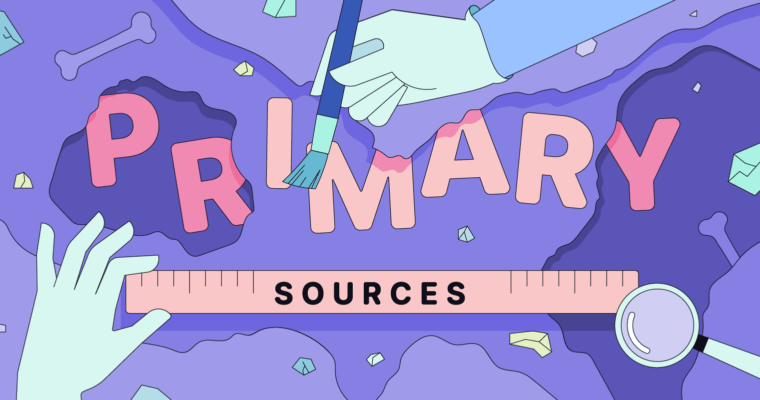
Primary sources are documents, images, relics, or other works that provide firsthand details of a historical or scientific event. Primary sources in history are often created by people who witnessed, participated in, or were otherwise close to a particular event. Secondary sources, on the other hand, are made by people who were not directly involved.
When writing a research paper, primary sources are ideal references, as long as you know how to handle them. In this guide, we give examples of primary sources and explain how to use them in academics, but first, let’s give a more detailed definition of primary sources.
What are primary sources?
Primary sources are any reference materials directly related to a historical event, such as an eyewitness account, a photograph or video of the incident, or a physical artifact. In research, primary sources make excellent references because they’re the next best thing to actually being there yourself.
By contrast, secondary sources are any reference materials that are not directly related to the event. Secondary sources often analyze and interpret primary sources to get a better understanding of the topic. For example, the court records of the Salem witch trials would be a primary source, whereas a book about how the Salem witch trials affected New England culture would be a secondary source.
Both primary and secondary sources are important for research, but primary sources tend to be more reliable because of their direct connection. At the same time, primary sources are usually harder to find (because there are fewer of them), so secondary sources help fill in the gaps and sometimes provide new information through deduction and context.
Primary source examples
So what are primary sources exactly? Here’s a quick list of some common types of primary sources:
- Photograph and video records
- Archaeological artifacts
- Data from scientific studies
- Artworks (paintings, poems, sculptures, etc.)
- Live recordings of speeches, music, and other performances
- Correspondence letters
- Diaries, memoirs, and autobiographies
- Legal documents (birth certificates, contracts, etc.)
- Interviews
- Journalistic articles from the time of an event (newspapers, magazines, etc.)
- Text of law codes
- Emails and text messages
- Original maps
- Social media posts
How to find a primary source
Finding primary sources can be a challenge since they’re not as common as other sources. Ironically, one of the best places to find primary sources is secondary sources.
Secondary sources should list their references and source materials, if not in the actual text then in footnote citations or the bibliography. Often, you’ll be able to track down these primary sources in a library or online database.
If you haven’t begun your research yet, journalistic articles are a good place to start. Newspaper and magazine articles written around the time of the incident count as primary sources if they have direct accounts of the event; if not, the article might still mention other primary sources.
There are also online resources where you can view primary sources. Here are some of the most common:
- WorldCat
- Internet Archive
- National archives (e.g., US National Archives, UK National Archives)
- Google Scholar
- Google Patents
- Wikisource
If you’re looking for the original hard copy of a source, such as artwork or artifacts, head to the museum! If you can’t reach the museum—perhaps it’s in another country—check its website, which usually has photographs of its popular exhibits.
How to evaluate a primary source
You always want to make sure your primary source is actually a firsthand account, not just posturing as one. People with a hidden agenda may pretend to be primary sources, so it’s best to evaluate a source’s authenticity whenever you can.
With official documents, you can verify the credentials yourself, and with published works, you can look into the authenticity of the publisher. But sometimes it’s difficult to evaluate a source’s credibility even with apparent verification. If you’re having trouble identifying a primary source, try asking yourself these questions:
- Who is the author or creator? Are they using their own experience as a reference, or someone else’s?
- Where did the source come from? Is it a scan, reprint, translation, or transcription? If so, how did they access the original?
- When was the source created? Does the time frame match the event you’re researching?
- Is the creator biased? Are they presenting the facts, or promoting their own ideology? Are they capitalizing on their experience for fame or money?
- What questions does this source answer? What questions does this source ignore or leave unanswered?
- Why was the source created? What was its purpose? For whom was it created?
- What is the historical context of the source? Does it fit with other sources from the same period?
Evaluating a source can take some detective work, so pay attention to the details. For example, if you’re using an online source, the URL can be helpful: Only official sites use .gov or .edu, whereas virtually anyone can create a .com, .org, or .net.
Don’t be afraid to research the source of the source. Check a website’s “About” page or an organization’s contact information to see if they’re legitimate. Do some research on the creator to see if they’re qualified. Pay attention to small discrepancies, such as citing different dates or spellings than other sources. Remember: Not all that glitters is gold!
How to use a primary source
If you want to use a primary source in academic writing, you have to follow certain protocols to be taken seriously. Above all, you need to properly cite both primary and secondary sources. It’s not enough to give credit to these sources in your writing; you have to credit them in a precise way that depends on which style guide you’re using.
The three most accepted style guides for academics are MLA, APA, and Chicago. Each one uses its own format for source citations, both in the bibliography and within the text, and these vary depending on the type of source, such as a book, image, or film. Often, the style guide is predetermined by the assignment or the organization you’re writing for.
Primary sources FAQs
What is a primary source?
A primary source is any reference material that presents a firsthand account of an event, such as from an eyewitness or someone directly involved. Official papers, such as legal documents, are also considered primary sources.
What are some examples of primary sources?
Primary sources are photographs, videos, artifacts, data from scientific studies, letters, diaries, autobiographies, legal documents, some journalistic articles, emails, social media posts, and other firsthand accounts.
Where can you find primary sources?
Primary sources are typically found in libraries, museums, and official online resources, such as national archives.
How do you use primary sources?
It’s important to properly credit a primary source using the citation guidelines from the style guide you’re using, such as MLA, APA, or Chicago.





